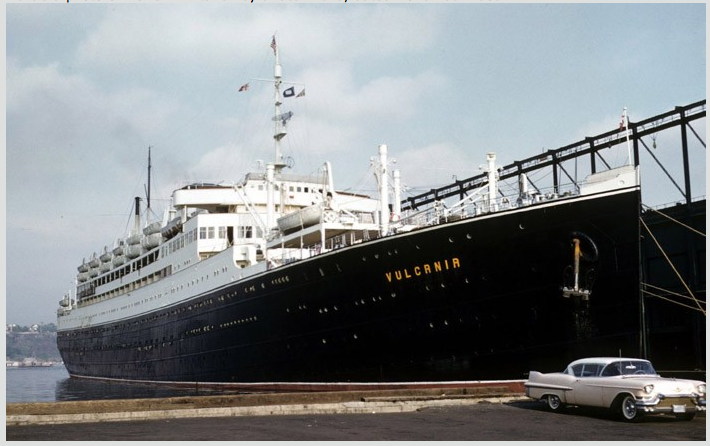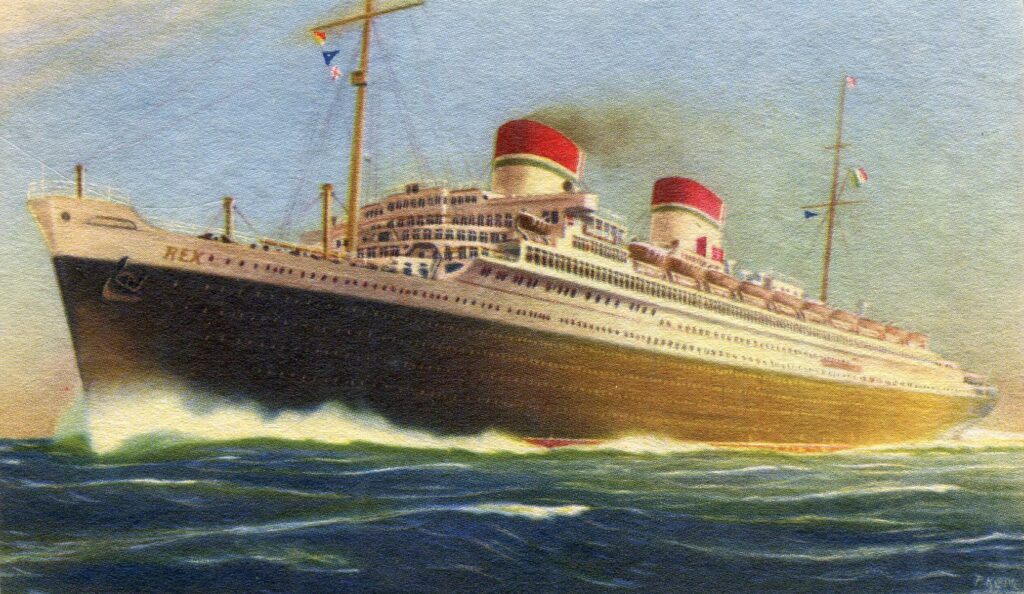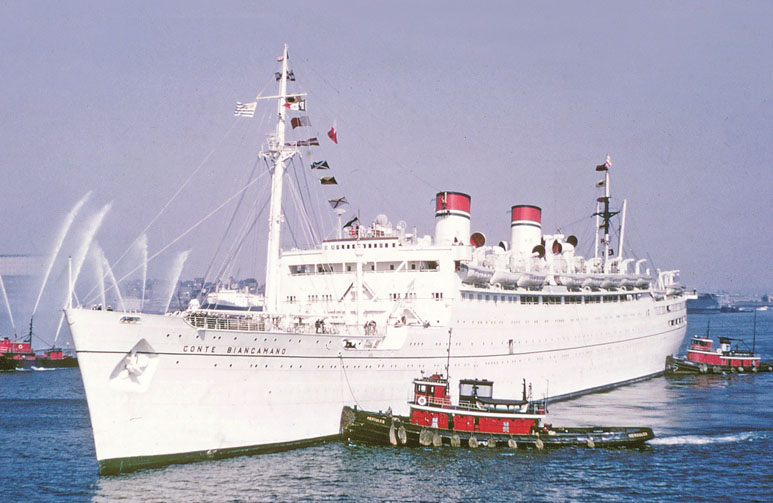One of the fond memories of my early years was visiting ships docked in New York harbor. In the 1950s and early ’60s, my father worked at the Brooklyn Navy Yard and had a paesano who was chief engineer on a cruise ship. With such connections, dad often took my older brother and me aboard warships and the Oceanic, a mainstay of Carribean cruises.

Those days, and the decades before, saw many Italian passenger ships plying the Atlantic. The workhorses of that trans-Atlantic trade well into the 1960s were the Saturnia and Vulcania. Built in the 1920s and named for Roman gods, they did the Atlantic crossing as well as ferry Italian troops to Abyssinia during that war in 1935-36. Their big brother was the Rex (‘King’ in Latin), built in 1931 to project a dynamic Fascist Italy into the luxury Atlantic run. Rex captured the Blue Ribbon award for speed in 1933 (33.28 mph) and held it until 1935. (Peroni still labels its beer “Blue Ribbon” – Nastro Azzurro – to commemorate this achievement.)
Rex and its sister ship Conte di Savoia were also the pride of the Italian American community during the 1930s. These sleek, modern vessels put Italy in the forefront of luxury travel. When schedules permitted, the ships’ ballrooms were rented by Italian American organizations while at dock to host gala dinners and large gatherings.
Neither Rex nor Conte di Savoia survived World War II. However, Vulcania and Saturnia miraculously escaped harm while serving in the war zones. Evacuating Italian colonists and ferrying soldiers to and from Africa the ships never lost a soul. At one point the Saturnia became an Italian hospital ship painted white with red crosses. By war’s end, the ships were surrendered to the Americans and used as a troop transport (Vulcania) and a hospital ship (Saturnia).

Another luxury liner with an amazing story is the Conte Biancamano (Count “white hand”), the nickname of a Savoy noble. Launched in 1925, it served both the Italian cruise line and Mussolini’s military before WW II. In 1939, it carried German Jewish refugees from Genoa to Shanghai to escape Nazi genocide. In April 1941 it was illegally seized at the Panama Canal by the U.S. before our entry into the war. Rechristened ‘Hermitage,’ it landed 6,000 American troops in North Africa (1942, Operation Torch) and later at Normandy (1944, Operation Overlord). In between, it transported thousands of refugees to safety in the Pacific Theater. At war’s end, ‘Hermitage’ sailed victorious GIs back to the states from Europe. Without rest, the ship swung over to the Pacific again to repatriate thousands of GIs from that theater. By the time the U.S. was finished with Biancamano it had logged 230,000 miles and transported 129,695 passengers of at least nine nationalities. ‘Slightly used,’ it was returned to Italy in 1947.

After the Second World War, Saturnia brought an estimated 265,000 Italian immigrants to Canada and the U.S. Vulcania no doubt hauled the same number but was assigned for a time to the southern run to Argentina and Brazil populating those nations with ambitious Italian immigrants. Both ships contained Catholic chapels and were billed as the only vessels in the world authorized to carry the Blessed Sacrament on board at all times. (My father and older brother Dennis sailed on Saturnia in 1949 on a visit to Italy and returned on Vulcania.)
There were a lot more Italian cruise ships plying the Atlantic from the 1920s to the 1950s: Giulio Cesare, Conte Verde. Duilio, Roma, Conte Grande, Conte Rosso, Augustus, Neptunia, and Oceania. Most didn’t survive the war.
To recapture the prestige of the Atlantic crossing after the war, Italians launched a new fleet of superliners in 1951: Giulio Cesare II, Augustus II, and the largest and fastest, Andrea Doria. But that’s another story. -JLM

Fascinating! Italians used to rule the air, too, via Alitalia Airlines.
That, too, is another story–a sad one.
What Italy needs to build right now are migrant ships!
Migrant ships? To send illegals back I presume.
God, Mr. Mancini, I hope so!
That is a fascinating tale, The big pond crossings really were a continuation of Italian navigational science and technology, that even predated Columbus…….Reminded me too, that when I worked in the canneries in California, I worked with some Jews from Shanghai, who immigrated to California from that part of the diaspora. What a crazy interconnected world.. Those Jews could have been transported on the Biancamano!